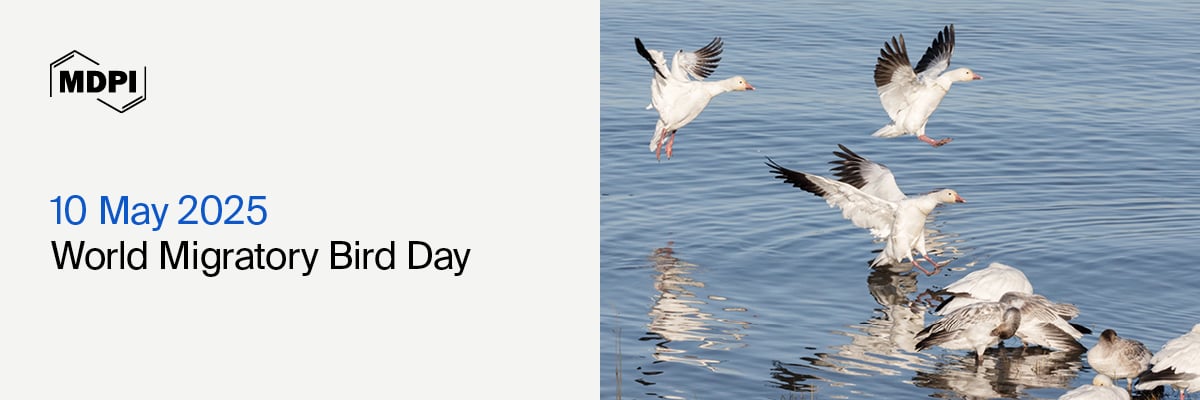World Migratory Bird Day (WMBD) is officially celebrated on the second Saturday of May in Canada and the US, and the second Saturday of October in Mexico, Central and South America, and the Caribbean. While the official dates are set, organizations and individuals are encouraged to celebrate and raise awareness about birds throughout the year by organizing relevant events and activities.
In 2025, WMBD will raise awareness about the many challenges migratory birds face due to human activities and expanding urban development. The campaign will advocate for strategic urban planning and conservation efforts that incorporate bird-friendly practices, making sure that our communities become havens for these remarkable travelers. The 2025 theme encourages action from all sectors, including national and local governments, businesses, community groups, and individuals worldwide.
We hope that established journals in the field of Environmental & Earth Sciences at MDPI, including Animals, Biology, Birds, Conservation, Ecologies, and Wild, will provide an invaluable platform for the exchange of innovative ideas regarding making our environment safe and welcoming for birds.


“Birds of Game Abundances in Evergreen Forests in Calakmul Biosphere Reserve, Campeche, Mexico”
by Héctor M. J. López-Castilla, Fernando M. Contreras-Moreno, Daniel Jesús-Espinosa, José M. Méndez-Tun, Khiavett Sánchez-Pinzón, Pedro Bautista-Ramírez, Lizardo Cruz-Romo and Sandra Petrone
Wild 2025, 2(1), 3; https://doi.org/10.3390/wild2010003
“Trends in the Application of Citizen Science in Waterbird Conservation: A Bibliometric Analysis”
by Ruilin Wang and Keming Ma
Animals 2025, 15(3), 368; https://doi.org/10.3390/ani15030368
“Mitigating Acute Climate Change Threats to Reintroduced Migratory Northern Bald Ibises”
by Johannes Fritz, Markus Unsoeld, Bernhard Goenner, Regina Kramer, Lisbet Siebert-Lang and Helena Wehner
Conservation 2024, 4(4), 748-761; https://doi.org/10.3390/conservation4040044
“Quantifying the Ecological Performance of Migratory Bird Conservation: Evidence from Poyang Lake Wetlands in China”
by Zhenjiang Song, Shichao Gao, Mingni Leng, Bo Zhou and Baoshu Wu
Biology 2024, 13(10), 786; https://doi.org/10.3390/biology13100786
“Comparing Energetics and Physiological Trait Patterns of North American Birds to Support Ecological Risk Assessment”
by Erik B. Muller, Carlo Romoli, Benoit Goussen, Jonathan D. Maul, Richard Brain and Nika Galic
Ecologies 2024, 5(3), 354-367; https://doi.org/10.3390/ecologies5030022
“Use of Stable Isotopes (δ13C and δ15N) to Infer Post-Breeding Dispersal Strategies in Iberian Populations of the Kentish Plover”
by Andrea Gestoso, María Vidal and Jesús Domínguez
Animals 2024, 14(8), 1208; https://doi.org/10.3390/ani14081208
“Simulation Modeling Unveils the Unalike Effects of Alternative Strategies for Waterbird Conservation in the Coastal Wetlands of Sardinia (Italy)”
by Alessandro Ferrarini, Marco Gustin and Claudio Celada
Biology 2023, 12(11), 1440; https://doi.org/10.3390/biology12111440
“Stopover Ecology of the European Turtle Dove (Streptopelia turtur), a Threatened Migratory Bird Species, after the Crossing of an Extended Ecological Barrier”
by Christos Barboutis, Anastasios Bounas, Elisabeth Navarrete and Thord Fransson
Birds 2023, 4(2), 202-212; https://doi.org/10.3390/birds4020017
“Using Pop-GUIDE to Assess the Applicability of MCnest for Relative Risk of Pesticides to Hummingbirds”
by Matthew A. Etterson, Elizabeth A. Paulukonis and S. Thomas Purucker
Ecologies 2023, 4(1), 171-194; https://doi.org/10.3390/ecologies4010013
“Blood Metabolites and Profiling Stored Adipose Tissue Reveal the Differential Migratory Strategies of Eurasian Reed and Sedge Warblers”
by Pedro M. Araújo, Ivan Viegas, Luis P. Da Silva, Pedro B. Lopes, Ludgero C. Tavares and Jaime A. Ramos
Birds 2022, 3(4), 359-373; https://doi.org/10.3390/birds3040024

















